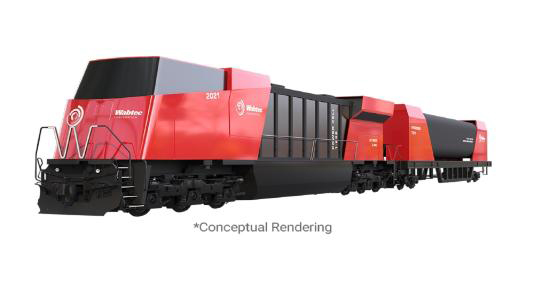
Research scientists and engineers from the Oak Ridge and Argonne national laboratories this week began a four-year research project with freight locomotive maker Wabtec Corp. aimed at substituting hydrogen for diesel fuel in diesel-electric train engines.
Pittsburgh-based Wabtec (NYSE:WAB) has already built a one-cylinder research diesel at Oak Ridge in Tennessee that will be the primary tool to investigate whether hydrogen can completely replace diesel or be burned in increasing percentages with the oily fossil fuel.
The company has previously investigated whether locomotive diesel engines could use a mixture of up to 80% natural gas and 20% conventional diesel in experiments to lower carbon emissions.
Wabtec has also built battery electric locomotives, which have tested both in switch yards and on a long-distance freight line. The company has a working agreement with the battery division of General Motors.
Battery weight is not a problem for a locomotive, but space to house the battery packs can be. And the cost to build the enormous battery packs is significant. Charging battery locomotives is another problem the company has investigated.
As for hydrogen, the current cost of hydrogen made with renewable energy is prohibitively high, but the Biden administration’s multi-faceted hydrogen programs, including billions in matching grants for the development of industrial hydrogen hubs along with significant tax credits for hydrogen production, are expected to lower to the price of clean hydrogen by the end of the decade.
 Artist’s conception | Oak Ridge Natinal Laboratory
Artist’s conception | Oak Ridge Natinal LaboratoryUnder the terms of the agreement with the two federal laboratories, multi-disciplinary teams of company and federal engineers, working also with software developer Convergent Science of Madison, Wis., will now focus on what hardware modifications will be needed to the single cylinder research diesel, and to its electronic control systems and accompanying software to enable the engine to run on mixtures of hydrogen and diesel fuel and ultimately on hydrogen alone.
The project “aligns with the goals of DOE’s Vehicle Technologies Office to use low-carbon fuels in hard-to-electrify transportation sectors,” according to Argonne.
“Hydrogen has been used in light-duty combustion engines. However, hydrogen is a newer area of research in railway applications,” said Muhsin Ameen, a senior research scientist at Argonne.
If the team’s experimental objectives are successful and locomotives now in service can be modified accordingly, rail companies “will be able to greatly reduce carbon emissions while maintaining commonality within their current fleet of trains,” Wabtec Vice President James Gamble said.
There are approximately 25,000 freight locomotives operating in the U.S., emitting about 87.6 billion pounds of carbon dioxide annually. Locomotives typically last at least 30 years, and Wabtec has developed a business division that re-conditions older locomotives with modern systems, extending their working lifetime.
Freight trains are typically pulled by three or more locomotives, and Wabtec has run an electric locomotive in series with conventional diesel-electrics, using the battery-electric locomotives’ re-charging systems to increase the overall efficiency of a train.
The federally funded combustion research with Wabtec is unlikely to win the endorsement of environmental groups that have targeted diesel engines for extinction.
Because the purpose of a diesel engine in a diesel-electric locomotive is to spin an alternator to generate electricity for drive motors on the locomotive’s axles, the company has focused initially on cleaning up the fuel and has come to view hydrogen as “the fuel of the future.”
Replacing the diesel engine in a diesel-electric locomotive with a fuel cell — if fuel cells stacks are eventually made large enough and able to ramp up power output as quickly as a diesel-driven alternator — could work, according to previous company interviews.
